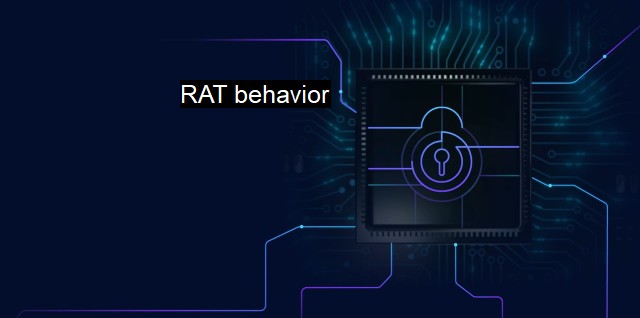What is RAT behavior?
Staying Safe in a RAT-Infested Cyber World: Understanding Behavior, Evasion, Persistence, and Protection
RAT or Remote Access Trojan behavior finds its place in the heart of cybersecurity discussions, posing severe threats to networks, systems, and individual devices. A RAT bolstered by malicious intent is a dangerous tool with capabilities to render unquantifiable damage, and is hence a primary concern of antivirus software developers and cybersecurity professionals alike. Dodge, duck, dip, dive, and dodge – this mantra from dodgeball resembles the underlying concept of RATs making them successful in invading security layers.A Remote Access Trojan (RAT), as the term suggests, is a type of malicious software disguised as legitimate ones, allowing hackers to remotely access and control your device once the Trojan has been executed. The stealthy nature of RATs plays a significant role in their danger. They can stay undetected in the system for prolonged periods, during which unauthorized intruders can access highly sensitive data, tamper with files, install more malware, monitor user behavior, and even exploit the resources of the infected device.
RAT behavior typically references malicious actions taken by an attacker after installing a Remote Access Trojan on a system. This Trojan enables the hacker to act as the administrator of your computer, giving them a broad range of offensive capabilities, including but not limited to manipulating files, watching on-going activities on the screen, deploying keyloggers to capture credentials, utilizing the camera for surveillance, or turning a system into a botnet participant for distributed cyberattacks.
Arriving usually as intriguing email attachments, deceitful downloads on the internet, or even via physical drive-by downloads, RATs can evade detection with alarming efficacy. Examples include well-known Trojans like Gh0st RAT, famously used for cyber espionage, or JBiFrost, primarily deployed for data theft and creating botnets.
Antivirus software plays a critical role in detecting and nullifying RAT behavior. Albeit the challenges, antivirus programs are equipped with advanced features that help in recognizing and dealing with such threats. These tools come with regularly updated virus databases to identify known malware, heuristic analysis to detect unusual behavior or unrecognized malware, sandboxing techniques to run suspicious programs in an isolated environment, and real-time protection scanners.
Cybersecurity includes human elements as well – where vigilant internet use and safe practices can deter the effectiveness of RATs significantly. Nobody wishes to serve their systems on a silver platter to cyber-attackers. Thus, it is recommendable to refrain from opening unknown email attachments, ensure secure downloading of applications only from trusted developers, employ strong passwords, and keeping operating systems and other applications up to date.
RAT behavior in cybersecurity is an ongoing concern. As antidotes develop, so do the poisons. Fighting against RATs is akin to a game of cat and mouse, wherein cybercriminals continuously hunt for new innovative backdoors while cybersecurity professionals strive to patch them.
The elusiveness and dangerous potential embedded in RAT behavior underline the conversation's criticality in the cybersecurity arena. Going forward, the technological world can expect a rise in RAT-alike cyber threats. Still, at the same time, advancements in security layers, machine learning algorithms, anomaly detection techniques, and user awareness can contribute significantly to mitigating these risks. Antivirus and cybersecurity companies, therefore, have a continual challenge of outpacing hackers by improvising, upgrading, and arming their defensive mechanisms.
When undetected and unchecked, RAT behavior can have delicate to disastrous consequences, affecting entities ranging from individuals to multinational corporations and even governments. as knowledge about these threats grows, sophisticated solutions to finding and combatting these invisible marauders are continually under evolution in the dynamic realm of cybersecurity.
Despite the stealth and impending threat that RAT behavior presents, its effective detection and adroit handling pave the way for a safer cyber environment. A good understanding of RATs can help cyber-aware individuals notice the 'harmless' software that could harbor menacing implications. When it comes to safeguarding against cyber threats, the adage "prevention is better than cure" holds entirely accurate, contextualizing the importance of cybersecurity and antivirus resources in our digitally synchronous existence.

RAT behavior FAQs
How can rats compromise my cybersecurity?
Rats, or remote access Trojans, can be used by hackers to gain remote access to a victim's computer, steal sensitive data, or carry out malicious activities.What are the common signs of rat behavior on a compromised system?
Some common signs of rat behavior include the presence of unusual processes or software, changes in system settings, unusual network traffic, and unauthorized access to files or applications.Can antivirus software detect and remove rats?
Yes, most antivirus software is equipped with rat detection and removal capabilities. However, it is important to keep your antivirus software up-to-date and perform regular system scans to ensure proper detection and removal of rats.How can I prevent rats from compromising my system?
To prevent rats from compromising your system, you should employ good cybersecurity practices such as using strong and unique passwords, keeping your software up-to-date with security patches, and avoiding suspicious emails or websites. You can also use antivirus software with advanced threat detection capabilities to protect your system from rats and other malware.| | A | | | B | | | C | | | D | | | E | | | F | | | G | | | H | | | I | | | J | | | K | | | L | | | M | |
| | N | | | O | | | P | | | Q | | | R | | | S | | | T | | | U | | | V | | | W | | | X | | | Y | | | Z | |
| | 1 | | | 2 | | | 3 | | | 4 | | | 7 | | | 8 | | |||||||